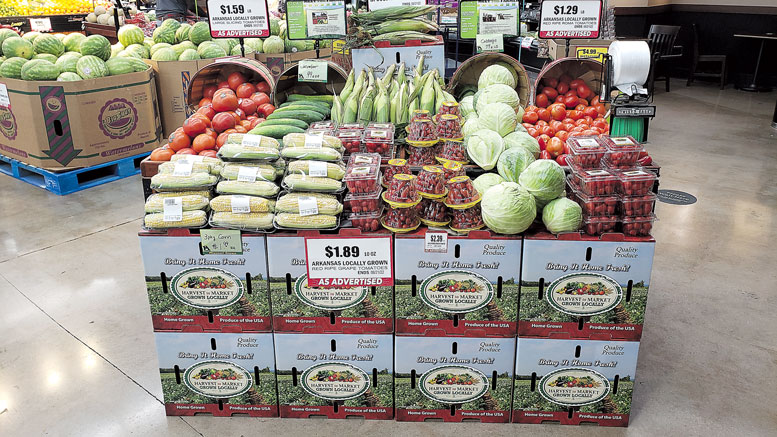There’s More in the Midwest
June 11, 2024 | 8 min to read
Today’s consumers, especially in the Midwest, are increasingly involved in the farm-to-table movement, desiring knowledge about where their food is sourced. The Midwest's proximity to 60% of the U.S. population enhances its position in supplying fresh produce, reducing food waste significantly. With a robust market for both traditional and emerging crops, retailers emphasize local offerings. As Michigan and Indiana adapt to evolving demands, the fresh produce industry remains vital and attuned to consumer preferences.

PHOTO COURTESY PYRAMID FOODS
The region is a vibrant source of produce, and is ‘local’ for many shoppers.
Originally printed in the May 2024 issue of Produce Business.
Today’s consumer wants to know where their food is grown, with Midwesterners especially interested.
“We’ve seen the trend of farm-to-table take root,” says Caroline Patrick, director of Indiana Grown, Indianapolis, IN. “Consumers are asking and wanting to be more involved in how, and where, the food they are consuming is being sourced.”
For example, she says a partner within the Indiana produce distribution sector has been working with a large regional chain restaurant group, “sourcing local products for their menus, not only regionally, but also specific to the state that the restaurant is in. So, in a couple of months, we will see menus highlighting and showcasing the products grown right within their own state.”
“The Midwest is unique in that we are one day away from 60% of the U.S. population,” says Kathy Michael Sponheim, co-owner, Michael Family Farms, Urbana, OH. “We grow a plethora of fruits and vegetables to feed those people.”
Although local is critical, the Midwest supplies fruits and vegetables across the United States, she adds. “We communicate that freshness, from having a one-day trip on a truck versus a three- to five-day trip, is a significant difference in quality, but also reduces food waste at the store level.”
Sponheim says the geographic position of the Midwest gives the region’s growers a lift, particularly these days, when consumers are concerned about supply chain and freshness issues.
“At Michael Family Farms, we are actively involved in the industry, and through this involvement, we utilize research and merchandising best practices to share with our retail partners,” she says.
Sponheim says produce traditionally popular in the Midwest continues to draw consumers elsewhere, and top commodities includes potatoes, sweet corn, apples, tomatoes, cabbage, pumpkins, bell peppers and cucumbers.
“However, new flavors and accessibility have given some support for varieties of berries, microgreens, Brussels sprouts and kale,” she says.
In Michigan, Trish Taylor, marketing manager, Riveridge Produce Marketing, Sparta, MI, says, one Midwestern commodity that will see some growth in coming years is sweet cherries.
“With the bulk of sweet cherries coming from the West, retailers are looking for ways to cut costs that result from freight,” says Taylor. “We have the ideal climate right here in Michigan for sweet cherry production and plan to increase packouts each year. Sourcing regionally decreases freight costs and carbon emissions from longer truck lanes.”
CROP OUTLOOK
As the year turned to spring, prospects for the Midwest growing area were positive. Sponheim notes, in April, the operation was still shipping its 2023 storage crop of round white, red and russet potatoes. “Quality in storage is good for the remainder of our inventory.”
She says a very mild winter overall in Ohio and Michigan, where Michael Family Farms operates, turned even warmer. Although the region had gotten a lot of rain in the first days of spring, temperatures pointed to planting in later April and May.
Miedema Produce, Hudsonville, MI, offers red radishes, parsnips, carrots and onions all year long, as well as a line of vegetables in season, ranging from zucchini and yellow squash to celery and items such as green cabbage and red leaf lettuce. Miedema Produce has farms in Michigan and Arizona to maintain supply through the year on key crops.
Todd Miedema says the winter had little snow cover, but that would have little impact on Miedema’s operations. “We’re more affected by rain in the summer than warm or cold winters,” he says. “We continue to function and operate just fine.”

PHOTO COURTESY MEIJER
Miedema says cycles rule in produce production regionally, both in weather terms and in consumption. The COVID-19 pandemic shook things up, particularly in the shift of demand from foodservice to retail and from bulk to packaged sales in stores, but a lot of that temporary shift has normalized.
Buurma Farms, Willard, OH, grows about 30 varieties of produce and started in mid-April.
“We’ll keep plugging away at our planning schedules until we get where we need to go,” says Chadd Buurma, company president. “We always tweak our planting schedules because of customer needs or tendencies in the industry. We spend a lot of time in the winter going over what we see as trends, and we’re planting according to that.”
The soft winter had little effect on Buurma Farms, although the early days of spring produced a bit of a nuisance. “If anything, we were a touch on the wet side here in the spring,” he says. “But that’s the reason we’re not going at it yet. We’re a week late, but that’s nothing major.”
At Michigan’s Riveridge Produce, which provides apples and cider all year long among other crops, the weather “has mostly cooperated,” says Taylor. “We had some early warm days that accelerated bud growth, but that was short-lived with the return of cool temperatures. We are about 10-14 days ahead by degree days and growth stages.”

PHOTO COURTESY HEARTLAND PRODUCE COMPANY
Diane Smith, executive director of the Michigan Apple Committee, Lansing, MI, says Michigan is “shaping up to have a full crop of Michigan apples for this fall.”
Patrick, of Indiana Grown, says produce grown in the Hoosier State had good growing conditions as winter was giving way to spring. “Thankfully we haven’t had a drought in a few summers,” she says. “Cantaloupe, watermelons, tomatoes, pumpkins for fresh market are all top Indiana commodities grown outside of a grow house.”
Patrick points to a phenomenon that is having an impact throughout the Midwest — the expansion of greenhouse and other controlled atmosphere growing operations.
“Indiana growers are adapting controlled environment growing conditions into their operations. Being able to grow lettuces, herbs, microgreens and cold-tolerant produce allows Indiana growers to provide consumers with product all year.”
MIDWEST = LOCAL
In general, food retailers in the Midwest are anxious to promote local produce all year long and in season.
“Our local chains support locally grown produce,” says Buurma. “They’re already calling, inquiring, when are we going to get started with the homegrown radish, the homegrown lettuce, the homegrown this and that. They know that it’s not next week, but they’re all anxious to get going. They advertise that heavily in their stores.”
He says the consumer “leans toward that homegrown deal.”
Anthony’s Produce, St. Peters, MO, is a full selection retail and wholesale produce market, specializing in locally grown produce and locally made products. Owner Mike Orlando says some shifts in demand are evident.
“Tomatoes are taking a head of steam, both regular heirloom and Roma,” he says, but adds that some of the specialty items in commodities, such as asparagus, turnips and potatoes, are cooling off.
WHOLESALE STABLE AND EVOLVING
On the wholesale side of the operation, Orlando says business seems to be getting better. “Wholesale produce is definitely more stable than it was two years ago.”
Labor continues to be an issue at Anthony’s Produce and throughout the produce sector. For growers, higher costs associated with the federal H-2A temporary agricultural worker program, especially regarding consistent wage increases, are a challenge. For Anthony’s Produce, the situation is a little different and, to an extent, more localized.
“Every year, minimum wage increases in Missouri,” says Orlando. “Gas prices are as high as they’ve been in a long time, and supplies, such as containers, trays and other things, are at an all-time high. These things factor into what we have to charge on the retail side.”

PHOTO COURTESY BEN B. SCHWARTZ & SONS
In Detroit, MI, Jordan Grainger, vice president of sales and business development, at wholesaler Ben B. Schwartz & Sons, says they’ve had a positive sales trend for the past several years. “The fresh produce industry is constantly evolving to keep up with changing consumer demands.”
The recent dynamics experienced by the business are consistent with what might be expected in the produce sector, he says. “We have continued to carry a wide variety of produce,” says Grainger. “Some years, sales are better on certain commodities, but there are many factors that go into those sales fluctuations, especially in produce with so many variables.”
He, too, cites labor as an ongoing issue, but not the only one that makes for choppy navigation.
“Uncertainty with the economy and inflation have seemed to shift some consumer purchases to lower cost per pound produce items,” says Grainger.
For Ben B. Schwartz, specialty produce is among the market segments that have been gaining, with ‘local’ being consistently in demand.
“Local/regional produce has always been an important part of our market,” says Grainger. “Consumer demand on specialty produce has been growing. With more exposure to produce varieties, it has driven more repeat purchases and consumption from consumers.”
12 of 16 article in Produce Business June 2024

